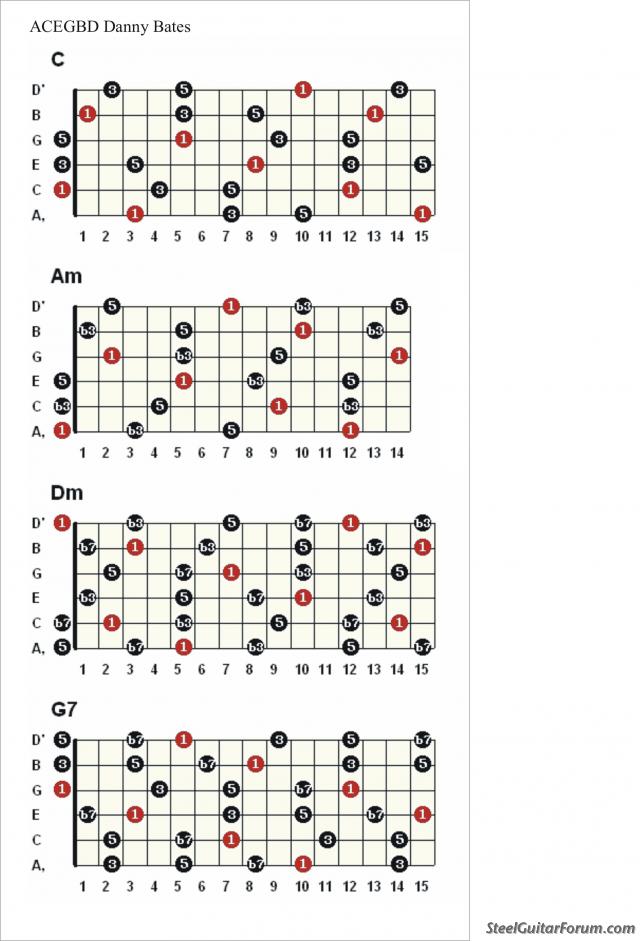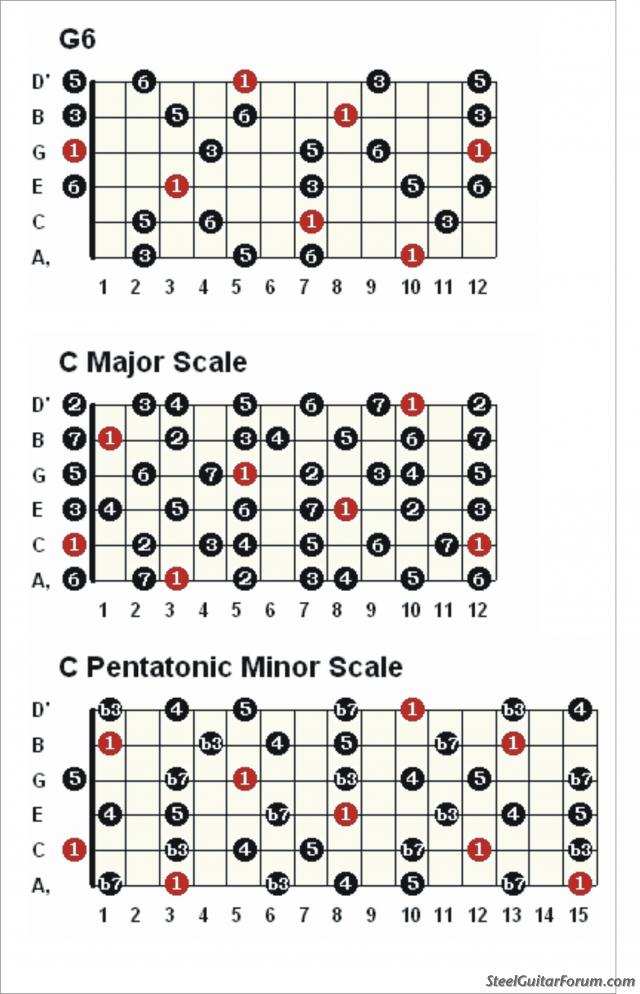Ray Langley wrote:
Rick, since your information is so important, I wonder if you would mind taking the time to expound on it a little more?
I'll try ...
The idea behind the JB style of melody w/ harmony ... is to keep the melody "flowing" ...
IE: Stay on the same string (or give the illusion of "staying" on the same string) ... and use straight bar, forward slants, reverse slants and "split slants" ... to add in appropriate* harmony notes ...
Most often this is not done using "Full Chords" ... picked or strummed ... but just one or two harmony notes ... added below the melody note.
Most of these harmony notes are usually ... Major/Minor
Third Intervals ... Major/Minor
Sixth Intervals ... And
Perfect Fifths ...
Also, could you please show us how the same
principle would apply using parallel sixths harmonies?
Here you go ...
Code: Select all
1-6 IV, VIm
2-7 V7, VIIo
3-1 I, VIm
4-2 IIm, VIIo
5-3 I, IIIm
6-4 IV, IIm
7-5 V7, IIIm,
Your concept will work exactly the same for any tuning, in any key, right? My diagram is for any of the Open E type tunings where the top four strings are tuned to: EG#BE,lowest to highest.
To keep on topic with the E13thTuning, the two bass strings could be tuned to any combination of either E, B, C#, or D.
According to my diagram below, at the very top we have a 3 and a 5 on strings
3 and 2. These notes are G# and B (in the Key of E).
So, if I understand this all correctly, this double-stop can be played over an E chord or a G# minor chord.
At fret 10, we have tones 2 and 4 from the E Major Scale. These notes are named F# and A. This double-stop will harmonize well with either a B7, F# minor, or a (half) D# diminished chord.
It all of that correct?
Yes ...
I always thought that double-stops were used to play the melody, and that any of them in either 3rds or 6ths harmony sounded great when playing any melody. Am I missing something?
The idea is to use the appropriate (major or minor) interval ... that will allow the player to "keep the flow going" ...
IE: not cut off the strings from ringing ... while you jump to a different string combination / fret position ...
EX: Opening phrases of Drowsy Waters ... C6 Tuning
Code: Select all
---9-|9--10--9--7--5--|-----4--5--|-7-------
-----|----------------|-4---------|---------
-----|----------------|-4---------|---------
---9-|9--11--9--7--6--|-----4--6--|-7-------
-----|----------------|-----------|---------
-----|----------------|-----------|---------
A A E7
------7-|-7--9--7--5--4|-----4---|-5-------
--------|--------------|-4-------|---------
--------|--------------|---------|---------
------7-|-7--9--7--6--4|-----4---|-6-------
--------|--------------|-4-------|---------
--------|--------------|---------|---------
E7 E7 E7 A
Anyway ... JB chooses to use the appropriate* Major/Minor Sixth Intervals to harmonize most of this part ...
This allows him to stay on the first string for the vast majority of melody notes ... and the fourth string for the harmony notes ...
The only two "breaks" in this seamless run ... he "disguises" with impeccable timing ... blocking the ringing strings at the same moment he engages the other pair ... giving the illusion that no "break was made" ...
Similar to his "P'Tah" technique ... for single note playing ...
* Appropriate choices for the harmony note(s) :
1) Ones that correspond to the
chord being played at the time ...
Or ...
2) Choosing the harmony note from within the
Key that the song is being played in ...
This is necessary, because sometimes the melody note is not part of the chord being played ... at that given time.
This is seen in the first measure above ....
The melody note D and it's harmony note F# ... or ... the melody note B and it's harmony note D ...
Code: Select all
-10- --7--
---- -----
---- or -----
-11- --7--
Are not being sounded by the rhythm section's A Major chord ...
But they are found within the Key of A ... so they "fit" as part of that seamless section ... being played over that A Major chord.
I especially enjoyed your use of vibrato. Some would call it excessive.
Oh , they have ...



But I find solace listening to my Andy Iona, Dick McIntire and Bobby Nichols records ...
And once a year traveling to Joliet to hear the vibratos of ...
Hal Smith, Mike Scott, Bernice Honold, Warren Slavin, Frank Della-Penna and Mae Lang ...
I'm sure the vibrato-minimalists out there ... would change their "tune" ... upon hearing these living legends of Hawaiian Style steel guitar ...


Anyway ... I hope that helps ...




